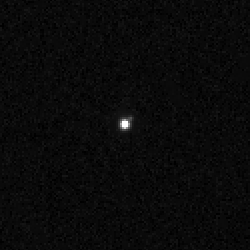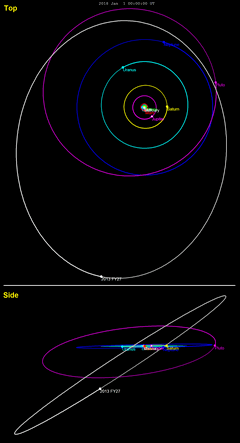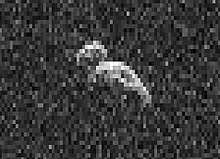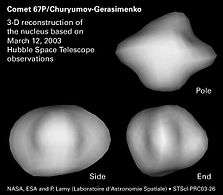2013 FY27
 2013 FY27 and its satellite, imaged by the Hubble Space Telescope on January 15, 2018 | |
| Discovery[1] | |
|---|---|
| Discovered by |
Scott Sheppard Chad Trujillo (807) |
| Discovery date |
17 March 2013 announced: 31 March 2014 |
| Designations | |
| MPC designation | 2013 FY27 |
| TNO, SDO[2] | |
| Orbital characteristics[3] | |
| Epoch 23 March 2018 (JD 2458200.5) | |
| Uncertainty parameter 7 | |
| Observation arc | 1852 days (5.07 yr) |
| Aphelion | 82.0857 AU (12.27985 Tm) (Q) |
| Perihelion | 35.7151 AU (5.34290 Tm) (q) |
| 58.9004 AU (8.81137 Tm) (a) | |
| Eccentricity | 0.39364 (e) |
| 452.05 yr (165034 d) | |
| 213.3220° (M) | |
| 0° 0m 7.849s /day (n) | |
| Inclination | 33.01929° (i) |
| 187.1453° (Ω) | |
| 138.7485° (ω) | |
| Known satellites | 1[4][5][6] |
| Earth MOID | 34.7719 AU (5.20180 Tm) |
| Jupiter MOID | 31.0895 AU (4.65092 Tm) |
| Physical characteristics | |
| Dimensions |
740+90 −85 km (primary), 190 km (secondary)[lower-alpha 1][4] 780 km (Brown)[7] 530[lower-alpha 2]–1100[lower-alpha 3] km[3][8] 900 km[9] |
|
0.170+0.045 −0.030[4] 0.15 (theoretically expected value)[7] | |
|
moderately red V-R=0.56±0.03, R-I=0.52±0.03[4] | |
| 22.1 | |
|
3.0 (JPL/MPC)[3] 3.3 (Brown)[7] 3.15±0.03 (Sheppard)[4] | |
|
| |
2013 FY27, also written 2013 FY27, is a trans-Neptunian object[3] that belongs to the scattered disc (like Eris).[9] Its discovery was announced on 31 March 2014.[1] It has an absolute magnitude (H) of 3.0,[3] which makes it very likely to be a dwarf planet.[7] 2013 FY27 is a binary object, with two components approximately 740 kilometres (460 mi) and 190 kilometres (120 mi) in diameter. It is the ninth-intrinsically-brightest known trans-Neptunian object,[10] and is the largest unnumbered minor planet as of September 2018.
Orbit

2013 FY27 orbits the Sun once every 452 years. It will come to perihelion around 2202,[lower-alpha 4] at a distance of about 36 AU.[3] It is currently near aphelion, 80 AU from the Sun, and, as a result, it has an apparent magnitude of 22.[1] Its orbit has a significant inclination of 33°.[3] The sednoid 2012 VP113 and the scattered-disc object 2013 FZ27 were discovered by the same survey as 2013 FY27 and were announced within about a week of one another.
| Most-distant known objects in the Solar System as of 2 October 2018[11] | ||||||||||||||||||||||||||||||||||||||||||||||||||||||||||||||||||||||||||||||||||||||||||||||||||
|---|---|---|---|---|---|---|---|---|---|---|---|---|---|---|---|---|---|---|---|---|---|---|---|---|---|---|---|---|---|---|---|---|---|---|---|---|---|---|---|---|---|---|---|---|---|---|---|---|---|---|---|---|---|---|---|---|---|---|---|---|---|---|---|---|---|---|---|---|---|---|---|---|---|---|---|---|---|---|---|---|---|---|---|---|---|---|---|---|---|---|---|---|---|---|---|---|---|---|
| Object name | Distance from the Sun (AU) | Apparent magnitude |
Absolute magnitude (H) | |||||||||||||||||||||||||||||||||||||||||||||||||||||||||||||||||||||||||||||||||||||||||||||||
| Current | Perihelion | Aphelion | ||||||||||||||||||||||||||||||||||||||||||||||||||||||||||||||||||||||||||||||||||||||||||||||||
| V774104 | 103? | Unknown | Unknown | 24 | 4 | |||||||||||||||||||||||||||||||||||||||||||||||||||||||||||||||||||||||||||||||||||||||||||||
| Eris | 96.10 | 37.8 | 97.6 | 18.7 | −1.1 | |||||||||||||||||||||||||||||||||||||||||||||||||||||||||||||||||||||||||||||||||||||||||||||
| 2014 UZ224 | 90.70 | 38.0 | 179.8 | 23.2 | 3.5 | |||||||||||||||||||||||||||||||||||||||||||||||||||||||||||||||||||||||||||||||||||||||||||||
| 2015 TH367 | 89.32 | 28.6 | 139.7 | 26.2 | 6.6 | |||||||||||||||||||||||||||||||||||||||||||||||||||||||||||||||||||||||||||||||||||||||||||||
| 2007 OR10 | 88.08 | 33.0 | 100.8 | 21.7 | 1.8 | |||||||||||||||||||||||||||||||||||||||||||||||||||||||||||||||||||||||||||||||||||||||||||||
| Sedna | 85.00 | 76.0 | 939 | 21.0 | 1.5 | |||||||||||||||||||||||||||||||||||||||||||||||||||||||||||||||||||||||||||||||||||||||||||||
| 2014 FC69 | 84.87 | 40.3 | 106.9 | 24.1 | 4.6 | |||||||||||||||||||||||||||||||||||||||||||||||||||||||||||||||||||||||||||||||||||||||||||||
| 2013 FS28 | 84.55 | 34.6 | 347.6 | 24.5 | 4.9 | |||||||||||||||||||||||||||||||||||||||||||||||||||||||||||||||||||||||||||||||||||||||||||||
| 2006 QH181 | 83.98 | 37.8 | 96.7 | 23.6 | 4.3 | |||||||||||||||||||||||||||||||||||||||||||||||||||||||||||||||||||||||||||||||||||||||||||||
| 2012 VP113 | 83.72 | 80.5 | 438 | 23.4 | 4.0 | |||||||||||||||||||||||||||||||||||||||||||||||||||||||||||||||||||||||||||||||||||||||||||||
| 2015 VO166 | 83.44 | 38.2 | 113 | 25.2 | 5.9 | |||||||||||||||||||||||||||||||||||||||||||||||||||||||||||||||||||||||||||||||||||||||||||||
| 2015 UH87 | 81.80 | 34.7 | 90.1 | 25.3 | 6.0 | |||||||||||||||||||||||||||||||||||||||||||||||||||||||||||||||||||||||||||||||||||||||||||||
| 2013 FY27 | 80.02 | 36.1 | 81.8 | 22.1 | 3.0 | |||||||||||||||||||||||||||||||||||||||||||||||||||||||||||||||||||||||||||||||||||||||||||||
| 2015 TG387 | 78.65 | 64.9 | 2120 | 24.3 | 5.3 | |||||||||||||||||||||||||||||||||||||||||||||||||||||||||||||||||||||||||||||||||||||||||||||
| 2017 FO161 | 78.57 | 33.1 | 93.9 | 24.2 | 5.2 | |||||||||||||||||||||||||||||||||||||||||||||||||||||||||||||||||||||||||||||||||||||||||||||
| 2015 TJ367 | 78.25 | 33.5 | 127.5 | 25.7 | 6.7 | |||||||||||||||||||||||||||||||||||||||||||||||||||||||||||||||||||||||||||||||||||||||||||||
| 2015 VJ168 | 72.90 | 37.4 | 81.3 | 24.6 | 5.8 | |||||||||||||||||||||||||||||||||||||||||||||||||||||||||||||||||||||||||||||||||||||||||||||
| 2010 GB174 | 72.16 | 48.7 | 693 | 25.1 | 6.5 | |||||||||||||||||||||||||||||||||||||||||||||||||||||||||||||||||||||||||||||||||||||||||||||
| 2015 GN55 | 71.56 | 32.7 | 78.4 | 24.5 | 5.8 | |||||||||||||||||||||||||||||||||||||||||||||||||||||||||||||||||||||||||||||||||||||||||||||
| 2014 FJ72 | 71.41 | 38.7 | 152.2 | 24.2 | 5.6 | |||||||||||||||||||||||||||||||||||||||||||||||||||||||||||||||||||||||||||||||||||||||||||||
| 2016 TS97 | 71.36 | 36.2 | 71.6 | 24.8 | 6.1 | |||||||||||||||||||||||||||||||||||||||||||||||||||||||||||||||||||||||||||||||||||||||||||||
| 2015 VL168 | 70.86 | 37.6 | 136 | 25.3 | 6.1 | |||||||||||||||||||||||||||||||||||||||||||||||||||||||||||||||||||||||||||||||||||||||||||||
| 2012 FH84 | 68.80 | 45.8 | 80.6 | 25.7 | 7.3 | |||||||||||||||||||||||||||||||||||||||||||||||||||||||||||||||||||||||||||||||||||||||||||||
| 2015 RZ277 | 68.45 | 34.3 | 90.0 | 25.5 | 6.8 | |||||||||||||||||||||||||||||||||||||||||||||||||||||||||||||||||||||||||||||||||||||||||||||
| 2015 GR50 | 68.41 | 35.6 | 78.6 | 25.1 | 6.7 | |||||||||||||||||||||||||||||||||||||||||||||||||||||||||||||||||||||||||||||||||||||||||||||
| 2015 GP50 | 67.87 | 40.3 | 70.3 | 24.8 | 6.5 | |||||||||||||||||||||||||||||||||||||||||||||||||||||||||||||||||||||||||||||||||||||||||||||
| 2013 FQ28 | 67.86 | 48.7 | 80.6 | 24.4 | 6.0 | |||||||||||||||||||||||||||||||||||||||||||||||||||||||||||||||||||||||||||||||||||||||||||||
| 2016 CD289 | 66.66 | 36.8 | 75.3 | 25.6 | 7.3 | |||||||||||||||||||||||||||||||||||||||||||||||||||||||||||||||||||||||||||||||||||||||||||||
| 2014 UD228 | 66.23 | 36.4 | 73.0 | 24.4 | 6.1 | |||||||||||||||||||||||||||||||||||||||||||||||||||||||||||||||||||||||||||||||||||||||||||||
| 2015 KV167 | 65.16 | 38.2 | 65.3 | 25.4 | 7.2 | |||||||||||||||||||||||||||||||||||||||||||||||||||||||||||||||||||||||||||||||||||||||||||||
| 2013 UJ15 | 65.06 | 36.3 | 69.2 | 25.2 | 7.0 | |||||||||||||||||||||||||||||||||||||||||||||||||||||||||||||||||||||||||||||||||||||||||||||
| 2014 FL72 | 64.69 | 38.2 | 170.4 | 25.0 | 6.8 | |||||||||||||||||||||||||||||||||||||||||||||||||||||||||||||||||||||||||||||||||||||||||||||
| 2014 FD70 | 64.51 | 38.6 | 69.3 | 25.0 | 6.9 | |||||||||||||||||||||||||||||||||||||||||||||||||||||||||||||||||||||||||||||||||||||||||||||
| 2015 KG172 | 64.05 | 42.1 | 68.7 | 24.1 | 6.0 | |||||||||||||||||||||||||||||||||||||||||||||||||||||||||||||||||||||||||||||||||||||||||||||
| 2014 SU349 | 63.50 | 30.8 | 109.8 | 25.0 | 7.0 | |||||||||||||||||||||||||||||||||||||||||||||||||||||||||||||||||||||||||||||||||||||||||||||
| 2015 RL258 | 63.35 | 34.7 | 67.8 | 24.7 | 6.5 | |||||||||||||||||||||||||||||||||||||||||||||||||||||||||||||||||||||||||||||||||||||||||||||
| 2015 KF172 | 63.23 | 38.2 | 102.8 | 23.6 | 5.5 | |||||||||||||||||||||||||||||||||||||||||||||||||||||||||||||||||||||||||||||||||||||||||||||
| 2015 RR245 | 63.02 | 33.7 | 129.2 | 22.1 | 3.9 | |||||||||||||||||||||||||||||||||||||||||||||||||||||||||||||||||||||||||||||||||||||||||||||
| 2011 GM89 | 62.87 | 37.2 | 68.8 | 25.6 | 7.1 | |||||||||||||||||||||||||||||||||||||||||||||||||||||||||||||||||||||||||||||||||||||||||||||
| 2013 AT183 | 62.77 | 36.0 | 88.1 | 22.0 | 4.7 | |||||||||||||||||||||||||||||||||||||||||||||||||||||||||||||||||||||||||||||||||||||||||||||
| 2014 FE72 | 62.47 | 36.3 | 4274.0 | 24.1 | 6.1 | |||||||||||||||||||||||||||||||||||||||||||||||||||||||||||||||||||||||||||||||||||||||||||||
| 2017 DO121 | 62.00 | 26.7 | 185.6 | 25.6 | 7.6 | |||||||||||||||||||||||||||||||||||||||||||||||||||||||||||||||||||||||||||||||||||||||||||||
| 2000 CR105 | 61.85 | 44.3 | 412 | 23.9 | 6.3 | |||||||||||||||||||||||||||||||||||||||||||||||||||||||||||||||||||||||||||||||||||||||||||||
| 2015 VG157 | 61.79 | 39.0 | 68.5 | 25.5 | 7.5 | |||||||||||||||||||||||||||||||||||||||||||||||||||||||||||||||||||||||||||||||||||||||||||||
| 2014 SV349 | 61.57 | 34.2 | 89.0 | 23.0 | 5.0 | |||||||||||||||||||||||||||||||||||||||||||||||||||||||||||||||||||||||||||||||||||||||||||||
| 2008 ST291 | 60.96 | 42.4 | 154.5 | 22.2 | 4.2 | |||||||||||||||||||||||||||||||||||||||||||||||||||||||||||||||||||||||||||||||||||||||||||||
| 2015 RX245 | 60.76 | 45.5 | 768.9 | 24.2 | 6.2 | |||||||||||||||||||||||||||||||||||||||||||||||||||||||||||||||||||||||||||||||||||||||||||||
| 2014 FM72 | 60.55 | 34.4 | 76.6 | 24.1 | 6.2 | |||||||||||||||||||||||||||||||||||||||||||||||||||||||||||||||||||||||||||||||||||||||||||||
| 2017 DP121 | 60.33 | 40.5 | 60.4 | 25.1 | 7.2 | |||||||||||||||||||||||||||||||||||||||||||||||||||||||||||||||||||||||||||||||||||||||||||||
| 2014 FF72 | 60.25 | 37.1 | 63.3 | 24.8 | 6.9 | |||||||||||||||||||||||||||||||||||||||||||||||||||||||||||||||||||||||||||||||||||||||||||||
| 2003 QX113 | 60.16 | 36.7 | 62.1 | 22.5 | 4.7 | |||||||||||||||||||||||||||||||||||||||||||||||||||||||||||||||||||||||||||||||||||||||||||||
| 2015 KH162 | 59.76 | 41.5 | 82.8 | 21.6 | 3.9 | |||||||||||||||||||||||||||||||||||||||||||||||||||||||||||||||||||||||||||||||||||||||||||||
| 2015 FU403 | 59.75 | 34.0 | 88.4 | 25.3 | 7.5 | |||||||||||||||||||||||||||||||||||||||||||||||||||||||||||||||||||||||||||||||||||||||||||||
| 2015 GW55 | 59.65 | 34.0 | 137.6 | 24.5 | 6.7 | |||||||||||||||||||||||||||||||||||||||||||||||||||||||||||||||||||||||||||||||||||||||||||||
| 2013 JQ64 | 59.40 | 22.6 | 76.0 | 24.4 | 6.2 | |||||||||||||||||||||||||||||||||||||||||||||||||||||||||||||||||||||||||||||||||||||||||||||
| 2015 RK258 | 59.03 | 35.8 | 111.8 | 24.9 | 7.1 | |||||||||||||||||||||||||||||||||||||||||||||||||||||||||||||||||||||||||||||||||||||||||||||
| This table includes all known objects currently located at least twice as far as Neptune.[11] See List of trans-Neptunian objects for more. | ||||||||||||||||||||||||||||||||||||||||||||||||||||||||||||||||||||||||||||||||||||||||||||||||||
Physical Properties
2013 FY27 has a diameter of about 740 kilometres (460 mi), placing it at a transition zone between medium sized and large TNOs. Using the Atacama Large Millimeter Array and Magellan Telescopes, its albedo was found to be 0.17, and its colour to be moderately red. 2013 FY27 is one of the largest moderately red TNOs. The physical processes that lead to a lack of such moderately red TNOs larger than 800 kilometres (500 mi) are not yet well understood.
The brightness of 2013 FY27 varies by less than 0.06 mag over hours and days, suggesting that it either has a very long rotation period, an approximately spheroidal shape, or a rotation axis pointing towards Earth.[4]
Satellite
Using Hubble Space Telescope observations taken in January 2018, Scott Sheppard found a satellite around 2013 FY27, 0.17 arcseconds away and 3.0±0.2 mag fainter than the primary. The discovery was announced on 10 August 2018.[12] Assuming the two components have equal albedos, they are about 740 kilometres (460 mi) and 190 kilometres (120 mi) in size, respectively.[4] Follow up observations have been taken between May and July 2018 in order to determine the orbit of the satellite,[5] but the results of those observations have not yet been released. Once the orbit is known, the masses and densities of the two components can be determined.
See also
Notes
References
- 1 2 3 "MPEC 2014-F82 : 2013 FY27". IAU Minor Planet Center. 2014-03-31. Retrieved 2018-03-29. (K13F27Y)
- ↑ "List Of Centaurs and Scattered-Disk Objects". Minor Planet Center. Retrieved 2014-04-02.
- 1 2 3 4 5 6 7 8 "JPL Small-Body Database Browser: (2013 FY27)" (last observation: 2018-04-12; arc: 5.07 years). Jet Propulsion Laboratory. Retrieved 9 September 2018.
- 1 2 3 4 5 6 7 Sheppard, Scott; Fernandez, Yanga; Moullet, Arielle (6 September 2018). "The Albedos, Sizes, Colors and Satellites of Dwarf Planets Compared with Newly Measured Dwarf Planet 2013 FY27". arXiv:1809.02184. Retrieved 9 September 2018.
- 1 2 Scott Sheppard (21 March 2018). "The Orbit of the Newly Discovered Satellite around the Dwarf Planet 2013 FY27 - HST Proposal 15460". Retrieved 9 September 2018.
- ↑ Scott Sheppard (7 April 2017). "A Satellite Search of a Newly Discovered Dwarf Planet - HST Proposal 15248". Retrieved 9 September 2018.
- 1 2 3 4 Mike Brown, How many dwarf planets are there in the outer solar system? Archived October 18, 2011, at the Wayback Machine. (assumes H = 3.3)
- ↑ Dan Bruton. "Conversion of Absolute Magnitude to Diameter for Minor Planets". Department of Physics & Astronomy (Stephen F. Austin State University). Archived from the original on 2011-07-23. Retrieved 2014-03-26.
- 1 2 Lakdawalla, Emily (2014-04-02). "More excitement in the outermost solar system: 2013 FY27, a new dwarf planet". www.planetary.org/blogs. The Planetary Society. Retrieved 18 January 2017.
- ↑ "JPL Small-Body Database Search Engine: orbital class (TNO) and H < 3.1 (mag)". JPL Solar System Dynamics. Retrieved 2014-03-31.
- 1 2 "AstDyS-2, Asteroids - Dynamic Site". Retrieved 2018-04-03.
Objects with distance from Sun over 59 AU
- ↑ "CBET 4537: 2013 FY27". cbat.eps.harvard.edu. 10 August 2018. Retrieved 9 September 2018.
External links
- Celestia Files of the recent Dwarf Planet finds (Ian Musgrave: April 6, 2014)
- Gaggle of dwarf planets found by dark energy camera (Aviva Rutkin: 2 April 2014)
- 2013 FY27 at the JPL Small-Body Database



_(cropped).jpg)
